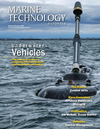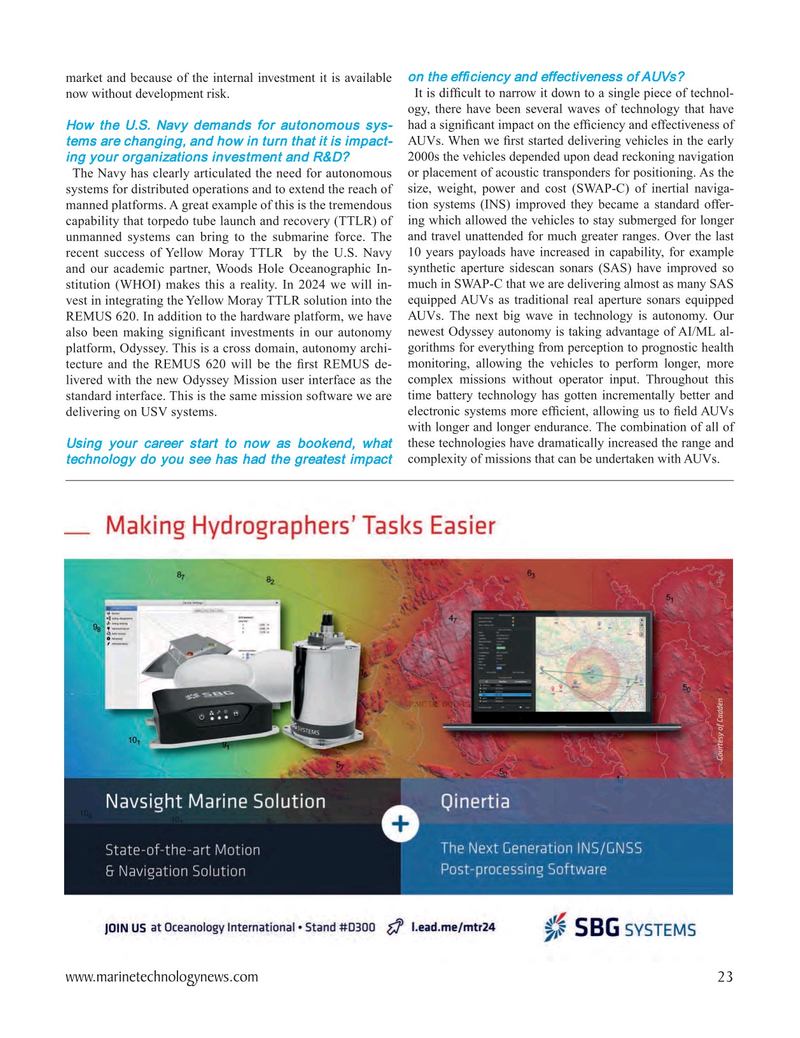
Page 23: of Marine Technology Magazine (January 2024)
Read this page in Pdf, Flash or Html5 edition of January 2024 Marine Technology Magazine
market and because of the internal investment it is available on the ef? ciency and effectiveness of AUVs? now without development risk. It is dif? cult to narrow it down to a single piece of technol- ogy, there have been several waves of technology that have
How the U.S. Navy demands for autonomous sys- had a signi? cant impact on the ef? ciency and effectiveness of tems are changing, and how in turn that it is impact- AUVs. When we ? rst started delivering vehicles in the early ing your organizations investment and R&D? 2000s the vehicles depended upon dead reckoning navigation
The Navy has clearly articulated the need for autonomous or placement of acoustic transponders for positioning. As the systems for distributed operations and to extend the reach of size, weight, power and cost (SWAP-C) of inertial naviga- manned platforms. A great example of this is the tremendous tion systems (INS) improved they became a standard offer- capability that torpedo tube launch and recovery (TTLR) of ing which allowed the vehicles to stay submerged for longer unmanned systems can bring to the submarine force. The and travel unattended for much greater ranges. Over the last recent success of Yellow Moray TTLR by the U.S. Navy 10 years payloads have increased in capability, for example and our academic partner, Woods Hole Oceanographic In- synthetic aperture sidescan sonars (SAS) have improved so stitution (WHOI) makes this a reality. In 2024 we will in- much in SWAP-C that we are delivering almost as many SAS vest in integrating the Yellow Moray TTLR solution into the equipped AUVs as traditional real aperture sonars equipped
REMUS 620. In addition to the hardware platform, we have AUVs. The next big wave in technology is autonomy. Our also been making signi? cant investments in our autonomy newest Odyssey autonomy is taking advantage of AI/ML al- platform, Odyssey. This is a cross domain, autonomy archi- gorithms for everything from perception to prognostic health tecture and the REMUS 620 will be the ? rst REMUS de- monitoring, allowing the vehicles to perform longer, more livered with the new Odyssey Mission user interface as the complex missions without operator input. Throughout this standard interface. This is the same mission software we are time battery technology has gotten incrementally better and delivering on USV systems. electronic systems more ef? cient, allowing us to ? eld AUVs with longer and longer endurance. The combination of all of
Using your career start to now as bookend, what these technologies have dramatically increased the range and technology do you see has had the greatest impact complexity of missions that can be undertaken with AUVs. www.marinetechnologynews.com 23
MTR #1 (18-33).indd 23 1/30/2024 8:34:07 PM

 22
22

 24
24
